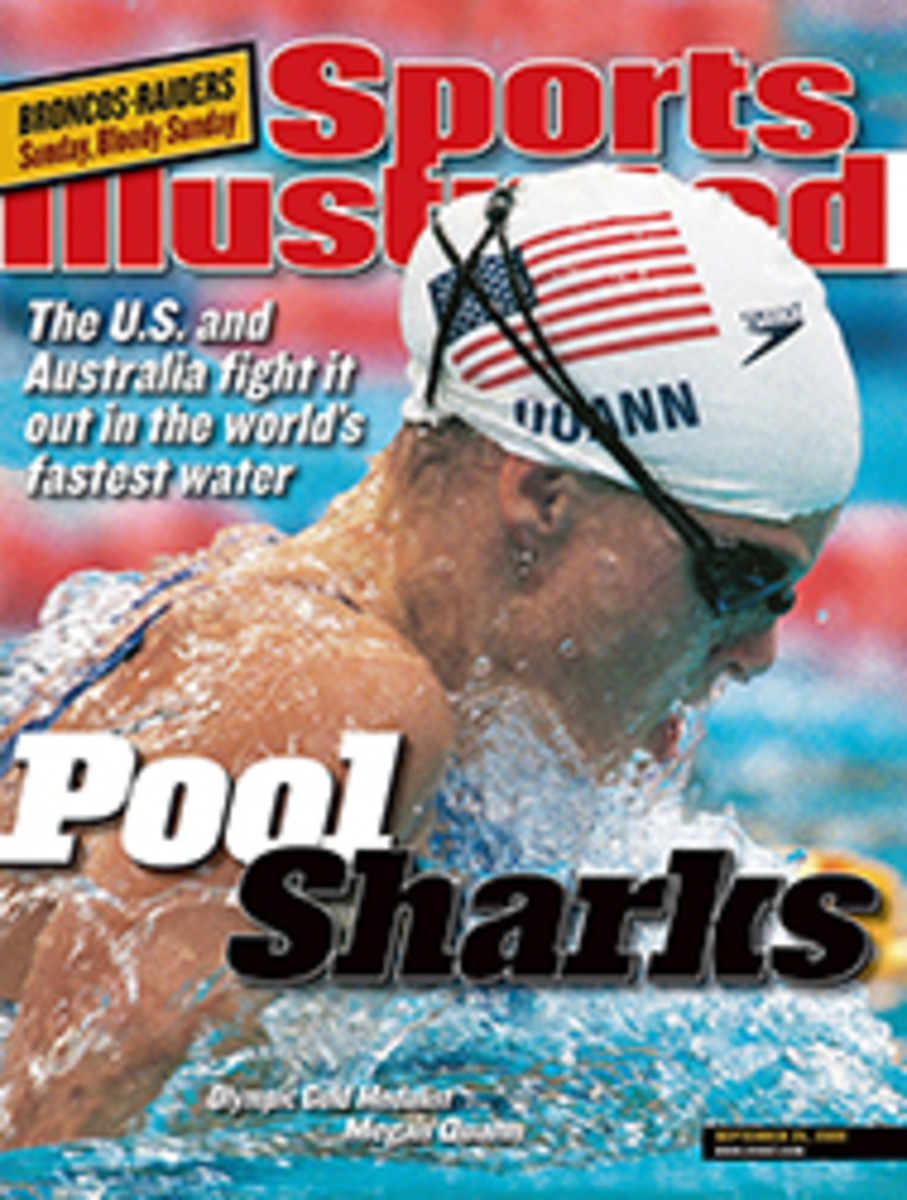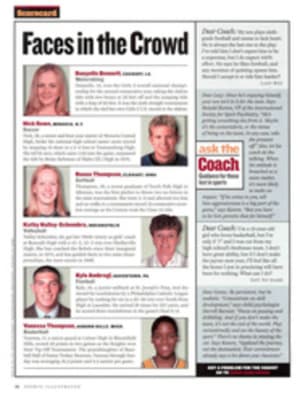
Straight A's Student Oakland ace Tim Hudson, a remarkably quick study, has moved to the head of the class of the game's young pitchers
All young major league pitchers go through an educational
process. But if you watch Tim Hudson pitch enough times, it
looks like he has gone through a good deal more than most.
--Rick Peterson, Oakland A's pitching coach
Perhaps the education of righthander Tim Hudson began on a dusty
Little League field in Phenix City, Ala....
Because it is 1984 and he is nine, Tim Hudson is Timmy Hudson, a
wisp of a boy barely big enough to ride the town fair's
Tilt-a-Whirl. Little Timmy Hudson is a dynamite athlete--quick
and fast and graceful--but clearly not a pitcher. Just look at
him: arms like pipe cleaners, legs like twigs. Look how his
Phenix City Cubs uniform hangs off his shoulders like a potato
sack. Look at his munchkin hands and Tweety Bird feet.
Look at him on the mound, pitching against the Indians. He has
never done this before. It shows. He walks the first batter. The
second. The third. And the fourth. He hits two others. His
teammates wilt in the blazing Alabama sun as pitch after pitch
misses the plate, as hitters flop back from his wildness. "I was
terrible," says Hudson, "but I didn't care. I loved it."
Timmy lasts one inning. It is the first of thousands of innings
he will pitch, but the second will not come until he's in high
school.
Perhaps the education of Tim Hudson began last season, in
Boston....
After striking out Nomar Garciaparra on a nasty split-fingered
fastball to end the sixth inning, Hudson shot a death stare at
the Red Sox shortstop. Garciaparra screamed at Hudson who, head
down, scowl completed, walked calmly toward the Oakland dugout.
Later that evening, while watching ESPN's SportsCenter, Hudson
saw a replay of the stare-down. He was shocked. "I had no idea I
was doing that," he said. "That's not me. That's not my style."
Ah, but it is. The stare-down has been Hudson's trademark. This
is not necessarily a good thing. "Tim doesn't always understand
how intense he can be," says A's second baseman Frank Menechino.
"But it's safe to say that the other teams notice." Last season,
when he was a nobody rookie, Hudson went 11-2 with a 3.23 ERA
while breaking every first-year commandment.
On the mound, the 6-foot, 160-pound Hudson struts like Fonzie in
the parking lot at Arnold's. He cuts down batters with a
devastating four-pitch repertoire (fastball, split-fingered
fastball, changeup, slider), then cuts them down again with his
gaze of death. "In the Old West, he would've been the guy
swindling everyone in cards and walking off with the best-looking
girl," says Oakland general manager Billy Beane. "He's got that
swagger."
He's got enemies too. Last month against the Cleveland Indians,
Hudson surrendered a second-inning homer to slugger Jim Thome.
Hudson's next pitch, a fastball, sailed inches from David Segui's
head. Like Garciaparra, Segui angrily shouted at Hudson. Both
benches cleared. "I'll be the first to admit it looked bad," says
Hudson. "But I was only trying to throw a fastball inside. It was
an accident--I swear to God. I don't like having people mad at
me." He pauses. "I never want to lose my aggressiveness, but I'm
not trying to show people up."
So here he is, in Oakland on a recent Saturday after dominating
the Tampa Bay Devil Rays on 94 pitches, 64 of them strikes, and
throwing a complete-game two-hitter in a 10-0 victory. He is, at
age 25, the best young starter in the American League, holding
opposing hitters to a .232 batting average, a mark bettered only
by Boston's Pedro Martinez and the New York Yankees' Roger
Clemens. Most telling, however, is that Hudson has struck out
four Tampa Bay batters without a single stare-down. After beating
the Devil Rays again, 5-2 last Saturday, Hudson is now 17-6 with
a 4.49 ERA.
Perhaps the education of Tim Hudson began at a practice field on
the Auburn campus....
Hal Baird, the Tigers' coach, looks at Hudson funny sometimes.
After all, the kid stands out. He is 20 years old, still a wisp
of a young man, recently removed from the safe haven of Phenix
City's Chattahoochee Valley Community College. That's where
Hudson wound up in 1993, immediately after graduating from
Glenwood High with a 12-1, 1.78 ERA career record and nary a
baseball scholarship offer. Pick a reason--any reason--why no
college coaches wanted Tim Hudson. "Too small, too light, too
unknown," says Russ Martin, Hudson's high school coach. "I told
every college coach I could find the same thing: Every now and
then you've gotta judge a kid by heart and guts, because this kid
will be a pretty doggone good player."
Only B.R. Johnson, Chattahoochee's coach and Martin's close pal,
listened. In two seasons at the school, Hudson turned into one of
the nation's best juco players--a hard-throwing starter who also
batted third as a DH. "His first year, we played a game at Gordon
Junior College, and he just shut them down," recalls Johnson.
"Their coach came up to me afterward and asked, 'Where'd you find
this kid?' The answer was easy: In our own backyard."
Hudson does not come from money. His father, Ronnie, is the plant
supervisor at a box company. His mother, Sue, is a housewife.
Every one of Hudson's coaches--from Martin to Johnson to
Baird--praises Hudson not as the strongest or fastest, but as the
most motivated. "He came from a family that had zero," says
Martin, "and he was driven to do something."
But this is Auburn, and during an early-season practice Baird is
skeptical. Hudson's fastball is so-so, his breaking ball is
hittable and his straight-over-the-top delivery is terribly
inefficient. In his first three outings of the '96 season, Hudson
gets pounded. Then something unprecedented happens.
Baird urges Hudson to learn the split-fingered fastball. He also
suggests that Hudson drop his arm to a three-quarters delivery.
Baird hopes that over the course of the season Hudson will
gradually change his style. "I remember the first time we
experimented with a lower arm angle," says Baird. "I could not
believe the movement he was getting. After three days his
split-finger was devastating. Three days! In 24 years I never had
a kid who made an adjustment on Monday and implemented it less
than a week later."
The rest is War Eagles history. In his two seasons under Baird,
Hudson became one of the best two-position players in college
history. As a senior centerfielder, he hit .396 with 18 home runs
and 95 RBIs. ("I am," admits Hudson, "the ultimate aluminum-bat
hitter.") As a pitcher he went 15-2 with a 2.97 ERA and 165
strikeouts in his senior year. He beat out Rice's Lance Berkman
and Florida State's J.D. Drew for the Rotary Smith Award, voted
on by college baseball SIDs, as college baseball's 1997 player of
the year. "Everything he's accomplished has been impressive,"
says Baird. "But when I think of Tim, what stands out is his
ability to pick things up and run with 'em. It's a gift."
Following his senior year Hudson is selected by the A's in the
sixth round of the June amateur draft. They like him a lot, but
they have some concerns. During the '97 SEC tournament, Hudson
was sidelined by inflammation in his right elbow. The A's believe
he needs to raise his arm in his throwing motion--not completely
over the top, as he threw in high school, but a nudge or two
higher. Hudson does...and perfects the new motion within days.
The inflammation goes away. His fastball, clocked at from 87 to
91 mph at Auburn, jumps to 90 to 94.
In the fall of 1997 Peterson, then the A's minor league pitching
coordinator, asks Hudson if he'd like to learn a changeup.
"Sure," says Hudson. Peterson shows him four possible grips.
Hudson tries the first grip and fires a strike from the bullpen
mound. "It was as good as any changeup he's ever thrown in the
big leagues," says Peterson. "Great arm speed, and the bottom
fell right out. Timmy turned to me and said, 'How was that?'
Uhhh, pretty good, Timmy. Pretty good." By June 1999, Hudson is
in the major leagues.
Perhaps the education of Tim Hudson began in the visitors'
clubhouse at Jacobs Field on April 20....
Hudson has just endured one of the worst performances of his
short major league career, allowing the Indians four runs and
five hits in 2 1/3 innings. It is his third straight terrible
outing. His ERA is up to 8.44. He is angry and frustrated and
confused. Last season everything was perfect. Batters chased his
changeup away and his split-fingered fastball in the dirt. He
rarely had to throw anything over the plate. "They didn't know
much about me, so they didn't know what to expect," says Hudson.
"But now they've seen me, and there are plenty of scouting
reports. It's a lot tougher."
Peterson repeats the word kaizen over and over to his pitchers.
It is Japanese, and it means "continuous improvement." In
Cleveland, on this day, Hudson decides he needs to get better. He
decides to make a big change in his pitching style: He will stop
trying to fool everyone, use his fastball more often and work on
spotting it perfectly.
Since that game against the Indians, Hudson is 16-4 with a 4.11
ERA. He has allowed a team-high 24 homers, but Peterson considers
that merely a bump in the road. "He's using his fastball in more
situations," Peterson says. "Sometimes it works. Sometimes they
hit it out of the park. But it's all about Tim getting
comfortable with the pitch. He'll have some rough times, but
that'll make him into a stronger pitcher. He's 25. There's a long
way to go and a lot more to learn."
Perhaps the education of Tim Hudson has just begun.
COLOR PHOTO: PHOTOGRAPH BY RICH FRISHMAN CRASH COURSE Four quality pitches, plenty of hard work and a very steep learning curve have made Hudson, at 25, the bulwark of the surprising A's.
COLOR PHOTO: BRAD MANGIN OVER THE TOP Opposing hitters have just a .232 batting average against Hudson this season.
TWO COLOR PHOTOS: TOM DIPACE (2)
Multiple Choice: Whom would you rather have: A, B, C, D or E?
Tim Hudson may be class valedictorian, but these other pitchers,
aged 25 or younger, are also acing their exams.
Rick Ankiel, Cardinals, 21, (9-7, 3.67 ERA): Ankiel (far right)
has one of the game's nastiest lefthanded curveballs and a good
fastball with movement. Control and high pitch counts are a
problem.
Kris Benson, Pirates, 25, (9-12, 3.18 ERA): Flashes of
brilliance but lacks consistency to match four quality pitches;
best is a knee-buckling curve.
Bartolo Colon, Indians, 25, (13-8, 4.25 ERA): Colon (left)
already has four postseason starts. Power pitcher who sometimes
gets too caught up in watching his radar-gun readings hit 100 mph.
Ryan Dempster, Marlins, 23, (12-10, 3.67 ERA): Has a Smoltz-like
slider; a strikeout machine (191 in 206 innings) who needs to
reduce his walks (90).
Scott Elarton, Astros, 24, (17-6, 4.77 ERA): Bounced back after
surgery on his right shoulder. At 6'7", 240 pounds, hides ball
well and has sinking, low-90s fastball.
"What stands out about Tim is his ability to pick things up and
run with 'em," says Baird. "It's a gift."

